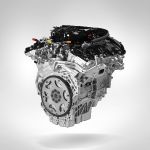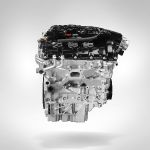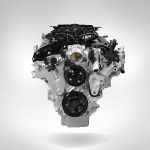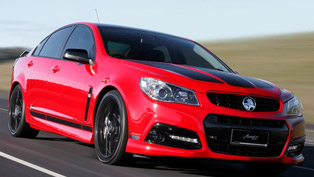Hi-Tech Engines Slash Commodore Fuel Use
Australia's favourite car, the Holden Commodore, is set to slash motorists' fuel use and running costs with two new advanced V6 engines and other technology improvements.
The Model Year 10 (MY10) Commodore range will go on sale in September with the most fuel efficient Australian-built six cylinder vehicle in the market.
Commodore Omega achieves just 9.3 litres of fuel per 100 kilometres in the official ADR81/02 test – up to 13 per cent better than current models – making it more efficient than some major four cylinder competitors.
At 9.3 litres, a motorist travelling 20,000 kilometres could save $325 at a current indicative price of $1.25 and produce 600 kilograms less carbon emissions. A fleet user travelling 40,000 kilometres could save $650 and 1.3 tonnes of CO2.
Holden will deliver the savings through two new engines offering the state of the art technology, Spark Ignition Direct Injection, a first for a locally-built vehicle.
An all-new 3.0-litre engine – the smallest Commodore powertrain offered to buyers in more than 20 years – and the familiar 3.6-litre displacement will be offered, depending on model.
The changes will be effective across the petrol sedan and Sportwagon range, as well as the SV6 Ute and the Statesman and Caprice long-wheelbase variants.
The engines are the centrepiece of a model year upgrade with fuel efficiency, lower running costs and consumer requirements firmly in mind.
A new six-speed automatic transmission will be matched with the new SIDI engines, weight reductions have been achieved, low rolling resistance tyres introduced and other fuel-saving upgrades installed.
The fuel efficiency achievements are among the most significant in Commodore's 31-year history as an Australian automotive mainstay.
The new technology conforms to strict Euro IV Plus emissions standards – currently the highest possible air pollution rating a petrol or diesel powered vehicle can achieve in Australia.
Using the Federal Government's Green Vehicle Guide as a measure, the Omega, Berlina sedan and Sportwagon and Calais sedan models achieve a 5.5 Greenhouse Rating and four stars.
GM Holden Chairman and Managing Director Mark Reuss said the introduction of the new engine technology would help Commodore to extend its 13-year reign as Australia's favourite car.
"People are telling us they want lower operating costs while keeping the flexibility of the Commodore's size – so that is exactly what we are offering," Mr Reuss said.
"Direct injection technology is a major step forward for the Australian car industry. It places a more refined Commodore amongst four cylinder competitors while delivering the space and flexibility which Australian car buyers clearly want.
"Australians and Australian families aren't getting any smaller, distances aren't getting any closer but customer expectations in terms of fuel efficiency and environmental impacts are changing fast.
"Holden understands that and this new technology is our response. It exploits the technology potential of an advanced, all-alloy engine made right here in Australia and makes it available to Australian car buyers."
Both SIDI V6 engines will join the Holden EcoLine range, designed to highlight the company's range of vehicles using alternative fuel or fuel saving technology.
All V6 engines for the Commodore range, Statesman and Caprice will be produced at Holden's Global V6 engine plant in Port Melbourne, Victoria. The vehicles are manufactured in Elizabeth, South Australia.
Engine overview
An all-new 3.0-litre SIDI engine – codenamed LF1 - will power the Omega and Berlina Commodore sedan and Sportwagon.
The 3.6-litre SIDI engine – codenamed LLT – will be available for the premium Commodore range including SV6, Calais and Calais V-Series models, as well as the SV6 Ute and the long wheelbase Statesman and Caprice range.
The 3.6-litre SIDI engine improves fuel economy in the premium models from 7 to 13 per cent. Calais boasts a 12 per cent improvement with fuel economy dropping from 11.2 to 9.9 litres per 100 kilometres on the ADR81/02 test cycle while retaining its luxury features and benefits.
CO2 emissions are significantly reduced with the 3.0-litre SIDI Omega sedan and Sportwagon boasting a 12 and 14 per cent improvement respectively.
All V6 SIDI models will receive a power upgrade. The 3.0 litre has increased output of 190kW from the 175kW of the previous engine, while the 3.6 litre is up from 195kW to 210kW per ECE regulations.
Spark Ignition Direct Injection Technology
Spark Ignition Direct Injection technology improves fuel efficiency while increasing available power and lowering emissions.
The technology works by injecting fuel directly into the combustion chamber allowing a higher compression ratio and precise fuel distribution.
By using a higher compression ratio, engine performance and efficiency is improved because less fuel is required to produce the equivalent kilowatts of power.
Direct injection technology also helps to reduce cold-start emissions by approximately 25 per cent.
The technology is found in more expensive European brands such as Audi and BMW. It has also been introduced in General Motor's flagship Cadillac brand in the United States.
Six-speed Transmission
With SIDI technology comes the 6L50 six-speed automatic transmission, delivering new levels of powertrain refinement with improved fuel economy, performance and shift feel.
The six-speed transmission allows reduced engine load at cruising speeds and a lower engine speed which improves fuel economy while reducing engine wear and noise.
Advanced clutch to clutch operations significantly reduce weight and size while reduced engine speed provides efficiency comparable to a manual transmission.
Fuel Efficiency
| Combined Fuel Consumption (l/100km) | |||||
| Vehicle | Engine | Transmission | MY9.5 | MY10 | Improvement |
| Omega sedan | 3.0L SIDI | Auto | 10.6 | 9.3 | 12% |
| Berlina sedan | 3.0L SIDI | Auto | 10.6 | 9.3 | 12% |
| SV6 sedan | 3.6L SIDI | Manual | 11.0 | 10.2 | 7% |
| SV6 sedan | 3.6L SIDI | Auto | 11.2 | 10.1 | 10% |
| Calais sedan | 3.6L SIDI | Auto | 11.2 | 9.9 | 12% |
| Calais V sedan | 3.6L SIDI | Auto | 11.4 | 10.1 | 11% |
| Omega Sportwagon | 3.0L SIDI | Auto | 10.7 | 9.3 | 13% |
| Berlina Sportwagon | 3.0L SIDI | Auto | 10.7 | 9.6 | 10% |
| SV6 Sportwagon | 3.6L SIDI | Auto | 11.3 | 10.3 | 9% |
| Calais Sportwagon | 3.6L SIDI | Auto | 11.3 | 10.3 | 9% |
| Calais V Sportwagon | 3.6L SIDI | Auto | 11.3 | 10.3 | 9% |
| SV6 Ute | 3.6L SIDI | Manual | 11.4 | 10.2 | 11% |
| SV6 Ute | 3.6L SIDI | Auto | 11.6 | 10.1 | 13% |
| Statesman | 3.6L SIDI | Auto | 11.5 | 10.3 | 10% |
| Caprice | 3.6L SIDI | Auto | 11.5 | 10.3 | 10% |
CO2 Emissions
| CO2 Emissions (g/km) | |||||
| Vehicle | Engine | Transmission | MY9.5 | MY10 | Improvement |
| Omega sedan | 3.0L SIDI | Auto | 252 | 221 | 12% |
| Berlina sedan | 3.0L SIDI | Auto | 252 | 221 | 12% |
| SV6 sedan | 3.6L SIDI | Manual | 260 | 242 | 7% |
| SV6 sedan | 3.6L SIDI | Auto | 266 | 241 | 9% |
| Calais sedan | 3.6L SIDI | Auto | 266 | 236 | 11% |
| Calais V sedan | 3.6L SIDI | Auto | 270 | 241 | 11% |
| Omega Sportwagon | 3.0L SIDI | Auto | 256 | 221 | 14% |
| Berlina Sportwagon | 3.0L SIDI | Auto | 256 | 228 | 11% |
| SV6 Sportwagon | 3.6L SIDI | Auto | 269 | 245 | 9% |
| Calais Sportwagon | 3.6L SIDI | Auto | 269 | 245 | 9% |
| Calais V Sportwagon | 3.6L SIDI | Auto | 269 | 245 | 9% |
| SV6 Ute | 3.6L SIDI | Manual | 269 | 242 | 10% |
| SV6 Ute | 3.6L SIDI | Auto | 274 | 241 | 12% |
| Statesman | 3.6L SIDI | Auto | 272 | 245 | 10% |
| Caprice | 3.6L SIDI | Auto | 272 | 245 | 10% |
LPG
Holden's popular dual fuel LPG range retains the 3.6-litre Alloytec Multi-point Fuel Injection V6 engine and delivers improved fuel economy and CO2 emissions.
Fuel efficiency is improved in the Omega sedan LPG from 14.2 to 13.4 litres per 100 kilometres per ADR81/02 – a six per cent reduction.
CO2 emissions are reduced six per cent from 230 to 217 grams per kilometre, making it the most carbon friendly vehicle in the Commodore range, achieving a greenhouse rating of six in the Green Vehicle Guide.
Pricing
Most models will achieve carryover pricing, despite the increased technology and running cost savings. Only the Omega and Berlina models will receive a $700 increase to the Recommended Retail Price.
Global V6 Engine Overview
Launched in 2003, the GM Global V6 engine family has powered a variety of car, truck and light commercial applications around the world.
The Global V6 engine family was created by GM to fulfil its strategy to build a new generation of sophisticated, engines for worldwide application in premium and high-performance vehicles. One of the prime objectives was to create a highly flexible platform from which a range of cost-effective variants could be developed.
The engine boasts all-aluminium construction and comes in various displacement sizes. The all-alloy construction offers features such as dual overhead camshafts, 24-valve per engine and continuously variable cam phasing. The engines can be used for front, rear or all wheel drive vehicles and are compatible with hybrid electric applications.
Global V6 Plant – Port Melbourne
Commencing in late 2003, the Port Melbourne Global V6 plant is one of General Motors' newest and most advance powertrain manufacturing facilities.
Given five years of strategic development, the manufacturing of global variants for markets around the world, the development of Holden's own Alloytec variant and the commissioning of a $400 million engine plant, the Global V6 engineering and manufacturing project is the most significant engine program ever undertaken by an Australian vehicle manufacturer.
Technical Specification
| ENGINE | 3.0L SIDI V6 (LF1) | 3.6L SIDI V6 (LLT) |
| Application: | VE MY10 | VE, WM MY10 |
| Type: | Internal combustion | Internal combustion |
| Displacement (cc): | 2997 | 3564 |
| Bore & stroke (mm): | 89.0 x 80.3 | 94.0 x 85.6 |
| Block material: | Sand cast aluminium (319) with cast in iron bore liners | Sand cast aluminium (319) with cast in iron bore liners |
| Cylinder head material: | Cast aluminium (319 semi permanent mould) | Cast aluminium (319 semi permanent mould) |
| Valvetrain: | DOHC 4 Valves / cyl | DOHC 4 Valves / cyl |
| Fuel delivery: | Direct Injection | Direct Injection |
| Compression ratio: | 11.7 : 1 | 11.3 : 1 |
| Horsepower (kW @ rpm): | 190 @ 6700 | 210 @ 6400 |
| Torque (Nm @ rpm): | 290 @ 2900 | 350 @ 2900 |
| Recommended fuel: | 91 RON | 91 RON |
| Emissions controls: | Euro IV+ | Euro IV+ |
| TRANSMISSION | 6L50E |
| TransmissionType: | Electronically controlled automatic overdrive transmission with torque converter clutch. Clutch to clutch architecture with integral Electro/ Hydraulic controls module |
| Gear ratios: (:1): | |
| First: | 4.06 |
| Second: | 2.37 |
| Third: | 1.55 |
| Fourth: | 1.16 |
| Fifth: | 0.85 |
| Sixth: | 0.67 |
| Reverse: | -3.2 |
| Final drive ratio: | 3.27 |









